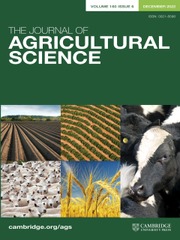Article contents
Influence of growing various crops in five fixed cropping sequences on the changes in phosphorus and potassium content of soil
Published online by Cambridge University Press: 27 March 2009
Summary
The results on the influence of growing various crops in five fixed annual sequences on the changes in available and total phosphorus and potassium content of a Tolewal sandy loam (Typic Ustipsamment) are reported. The available phosphorus content showed an increase in each of the five crop rotations after completion of two cycles. The maximum increase was observed in groundnut-based cropping sequences whereas the increase under the other three rotations was more or less of the same order. A slight decrease in the available P content during the 3rd year was observed after the harvest of bajra in a bajra fodder–potato–wheat sequence which was replenished after the harvest of potato and wheat. Total P content of the soil also showed an increase in all five rotations after completion of two cycles. A decrease in total P content of the soil was also observed after the bajra harvest. Balance sheet of P indicated net gain of P in all five crop rotations and the maximum gain of 62 kg P/ha was observed in the maize–wheat–moong rotation. Theavailable K status of the soil showed an increase in each of the five cropping sequences after completion of two cycles. The available K status after harvest of various crops in the rotation could not fully explain the dynamics of K availability. The total soil K content indicated a negative K balance in each of the five crop rotations after completion of three cycles and the maximum negative balance occurred in a maize–wheat–moong sequence. The negative K balance was related to the amount of fertilizer K added and that removed by the crops. The results suggested the need for modifying the existing K fertilizer recommendations to compensate gradual loss of native K soil fertility.
Information
- Type
- Research Article
- Information
- Copyright
- Copyright © Cambridge University Press 1987
References
- 2
- Cited by

